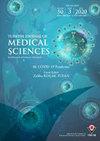Dynamic contrast-enhanced mammography and breast MRI in the diagnosis of breast cancer and detection of tumor size
IF 1.2
4区 医学
Q2 MEDICINE, GENERAL & INTERNAL
引用次数: 0
Abstract
. Background/aim: The aim of this study is to evaluate the performance of contrast-enhanced mammography (CEM) and dynamic breast MRI techniques for diagnosing breast lesions, assess the diagnostic accuracy of CEM’s using histopathological findings, and compare lesion size measurements obtained from both methods with pathological size. Materials and methods: This prospective study included 120 lesions, of which 70 were malignant, in 104 patients who underwent CEM and MRI within a week. Two radiologists independently evaluated the MR and CEM images in separate sessions, using the BI-RADS classification system. Additionally, the maximum sizes of lesion were measured. Diagnostic accuracy parameters and the receiver operating characteristics (ROC) curves were constructed for the two modalities. The correlation between the maximum diameter of breast lesions observed in MRI, CEM, and pathology was analyzed. Results: The overall diagnostic values for MRI were as follows: sensitivity 97.1%, specificity 60%, positive predictive value (PPV) 77.3%, negative predictive value (NPV) 93.8%, and accuracy 81.7%. Correspondingly, for CEM, the sensitivity, accuracy, specificity, PPV, and NPV were 97.14%, 81.67%, 60%, 77.27%, and 93.75%, respectively. The ROC analysis of CEM revealed an area under the curve (AUC) of 0.907 for observer 1 and 0.857 for observer 2, whereas MRI exhibited an AUC of 0.910 for observer 1 and 0.914 for observer 2. Notably, CEM showed the highest correlation with pathological lesion size (r = 0.660 for observer 1 and r = 0.693 for observer 2, p < 0.001 for both). Conclusion: CEM动态对比增强乳腺 X 线照相术和乳腺 MRI 在诊断乳腺癌和检测肿瘤大小中的应用
.背景/目的:本研究旨在评估对比增强乳腺 X 线造影(CEM)和动态乳腺 MRI 技术在诊断乳腺病变方面的性能,利用组织病理学结果评估 CEM 的诊断准确性,并将两种方法获得的病变大小测量值与病理大小进行比较。材料和方法:这项前瞻性研究包括在一周内接受 CEM 和 MRI 检查的 104 名患者的 120 个病灶,其中 70 个为恶性病灶。两名放射科医生分别采用 BI-RADS 分类系统对 MR 和 CEM 图像进行了独立评估。此外,还测量了病变的最大尺寸。为两种模式构建了诊断准确性参数和接收者操作特征曲线(ROC)。分析了核磁共振成像、CEM 和病理学观察到的乳腺病变最大直径之间的相关性。结果:MRI 的总体诊断值如下:敏感性 97.1%,特异性 60%,阳性预测值 (PPV) 77.3%,阴性预测值 (NPV) 93.8%,准确性 81.7%。相应地,CEM 的敏感性、准确性、特异性、PPV 和 NPV 分别为 97.14%、81.67%、60%、77.27% 和 93.75%。CEM 的 ROC 分析显示,观察者 1 的曲线下面积(AUC)为 0.907,观察者 2 为 0.857,而 MRI 观察者 1 的曲线下面积(AUC)为 0.910,观察者 2 为 0.914。值得注意的是,CEM 与病理病灶大小的相关性最高(观察者 1 的相关性为 0.660,观察者 2 的相关性为 0.693,两者的相关性均小于 0.001)。结论CEM
本文章由计算机程序翻译,如有差异,请以英文原文为准。
求助全文
约1分钟内获得全文
求助全文
来源期刊

Turkish Journal of Medical Sciences
医学-医学:内科
CiteScore
4.60
自引率
4.30%
发文量
143
审稿时长
3-8 weeks
期刊介绍:
Turkish Journal of Medical sciences is a peer-reviewed comprehensive resource that provides critical up-to-date information on the broad spectrum of general medical sciences. The Journal intended to publish original medical scientific papers regarding the priority based on the prominence, significance, and timeliness of the findings. However since the audience of the Journal is not limited to any subspeciality in a wide variety of medical disciplines, the papers focusing on the technical details of a given medical subspeciality may not be evaluated for publication.
 求助内容:
求助内容: 应助结果提醒方式:
应助结果提醒方式:


